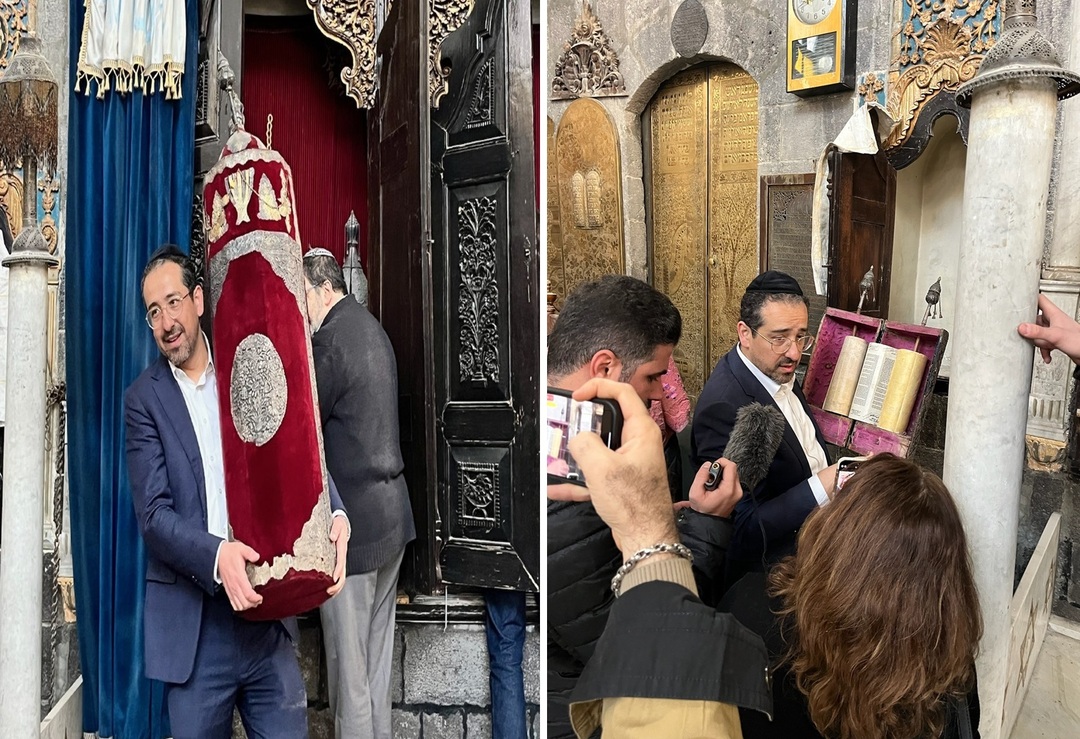-
With Henry Hamra Running for Syrian Parliament...Who Are Syria’s Jews?
-
Why did Syrian Jews emigrate abroad?

Nawras Yagan
After the fall of the Syrian regime on December 8, 2024, Syrian Jews, often referred to as the Mousawi community, returned to public attention for the first time in nearly 35 years.
The Jewish community of Syria is considered an ancient and integral part of Syrian society, having lived in the country for thousands of years before circumstances changed dramatically with the establishment of the State of Israel in 1948.
Historically, Syrian Jews were concentrated mainly in Aleppo, Damascus, and Qamishli. Initially, they were divided into two main groups that later merged almost completely. At the fall of the Ottoman Empire, their numbers were estimated between 50,000 and 100,000, but over time many emigrated in successive waves. The first left for the United States at the beginning of the 20th century, while others departed during the French Mandate, amid rising tensions linked to Zionist activities in Palestine. A large number remained after independence and the 1948 Nakba — their story took a different turn afterward.
Mizrahi and Sephardic Jews
The original Jews of Syria were Mizrahi, while those who arrived from Spain in 1492, following the fall of Andalusia, were Sephardic.
At first, there was a clear distinction in language and religious customs between the two groups. The Sephardim were concentrated mainly in Aleppo, while Damascus remained the stronghold of the Mizrahim.
Over time, however, Sephardic traditions and rituals came to dominate the cultural life of all Syrian Jews.
Life of Jews in Syria
Jews in Syria lived, as the Arabic saying goes, “through good times and bad.” They were primarily active in trade, as well as in culture and the arts, but had little to no presence in the political sphere, either during Ottoman rule or afterward.
During the French Mandate, many worked in government institutions and across various sectors. Several became well-known merchants and physicians, and some even served as members of parliament, though none ever reached senior positions in the state.
The year 1948 marked a tragic turning point. With the declaration of the State of Israel, Syrian Jews were suddenly viewed by successive governments as potential “traitors.” In 1947, even before Israel’s founding, the “Aleppo Riots” had erupted, during which angry mobs attacked the Jewish quarter, burning synagogues and homes.
After the Nakba: Discrimination and Persecution
After the Nakba of 1948, Syrian Jews faced systematic deprivation of basic rights, most notably freedom of movement and emigration. Successive governments, including that of the Assad regime, completely banned Jewish emigration. Until the early 1990s, Syria remained the only country in the Middle East that prohibited its Jewish minority from leaving the country altogether.
To enforce this discrimination, the authorities implemented harsh surveillance measures. National ID cards of Jewish citizens were stamped with the word “Mousawi” (Mosaic/Jewish) in bright ink, making it easy to single them out in job applications and official transactions.
Severe restrictions on internal travel were also imposed; Jews had to obtain special permits to move between neighbourhoods or cities. The old Jewish quarters in Damascus and Aleppo were placed under heavy intelligence monitoring.
A particularly cruel policy known as the “hostage system” was strictly applied to any Jew granted temporary travel permission for health or tourism reasons. Travelers were required to deposit large financial guarantees, sometimes up to $6,000 USD, and to leave a family member behind as collateral to ensure their return. This system kept the diaspora community under constant pressure and ensured continued leverage over them by the Syrian authorities.
Economic and Legal Restrictions
Alongside travel limitations, Syrian Jews endured systematic economic and legal exclusion. They were barred from working in public institutions or banks, denied driver’s licenses and telephone lines, and had their bank accounts frozen.
The state also seized many communal properties. For instance, a major road leading to Damascus International Airport was paved directly over the Jewish cemetery, and Jewish schools were closed, placed under Muslim administration, and stripped of their original identity.
Severe restrictions were also imposed on selling or transferring real estate and personal property. These measures lifted and reimposed intermittently were designed to prevent Jews from liquidating their assets before emigrating, ensuring that those who left departed without capital or that their property remained under state control.
Escape and the Final Exodus
These harsh measures forced thousands of Jews to emigrate illegally across the Turkish border. By the 1960s, their numbers had dwindled to around 5,000, and continued restrictions left only a handful within Syria today.
From the mid-1970s, Hafez al-Assad sought to use Syrian Jews for political leverage. Despite ongoing discrimination, some relief occurred, notably through the close relationship between Assad and Chief Rabbi Abraham Hamra (brother of Joseph Hamra and uncle of current parliamentary candidate Henry Hamra).
Geopolitical shifts and the Arab-Israeli conflict always influenced the community’s fate. During the Madrid Peace Conference, Assad presented himself as a guarantor and protector of the Jewish minority.
At the time, Syrian television produced an English-language documentary on Jewish life in Damascus, presented by Yahya Al-Aridi, which, alongside eased travel restrictions, allowed remaining Jews to emigrate gradually. By 1994, Syria was nearly devoid of Jews.
Under Bashar al-Assad: Damascus with Love
Under Bashar al-Assad, Syrian Jews remained largely absent from public life, but efforts were made to follow his father’s approach of cautious engagement. Jews were invited to return to Syria periodically, maintaining ties with the authorities.
During this period, several Jewish visitors came to Syria regularly, reflecting the continued close relationship between the Assad family and Abraham Hamra, which extended to Bashar after Hafez’s death.
In 2010, the General Cinema Organization produced a film titled Damascus with Love, chronicling the return of a Jewish figure to the city.
When the Syrian revolution began, the Jewish community participated initially through solidarity and fundraising efforts, but soon withdrew again from public life.
Syrian Jews Today and Their Symbolic Return
The vast majority of Syrian Jews and their descendants, estimated at over 75,000 today, live in tight-knit communities outside Syria. The largest is in Brooklyn, New York, with smaller communities in Argentina, the UK, Mexico, and other countries.
Remarkably, these communities have retained a strong Syrian identity: elders still speak Arabic with Levantine or Aleppine accents, cook traditional Syrian cuisine, and maintain an emotional attachment to their ancestral homeland.
Their return to public attention today represents the recovery of a missing piece in the mosaic of Syrian diversity, requiring nuanced explanations of both its causes and potential impact on Syrian society.
Popular Posts
opinion
Stay Connected
Newsletter
Subscribe to our mailing list to get the new updates!


